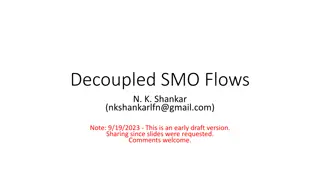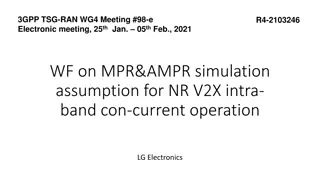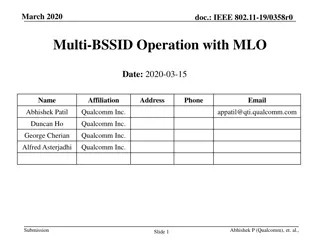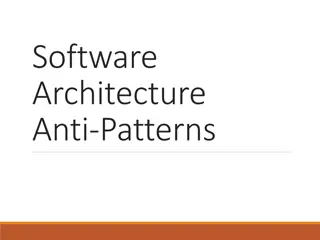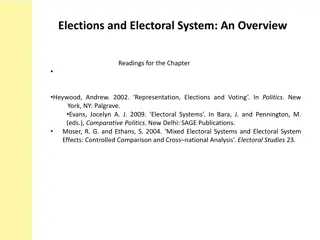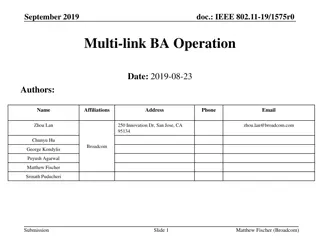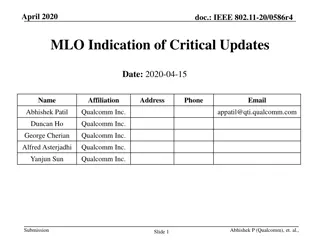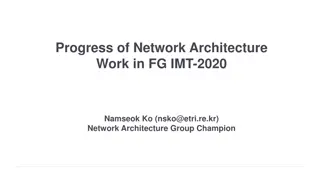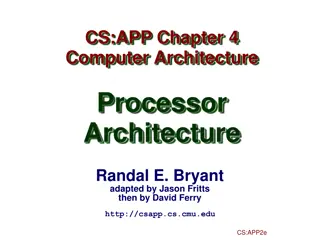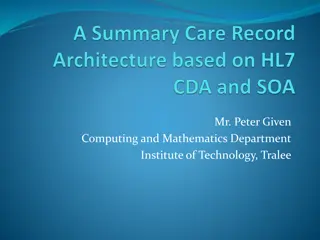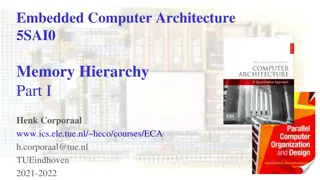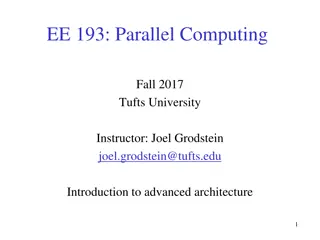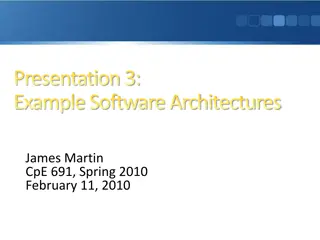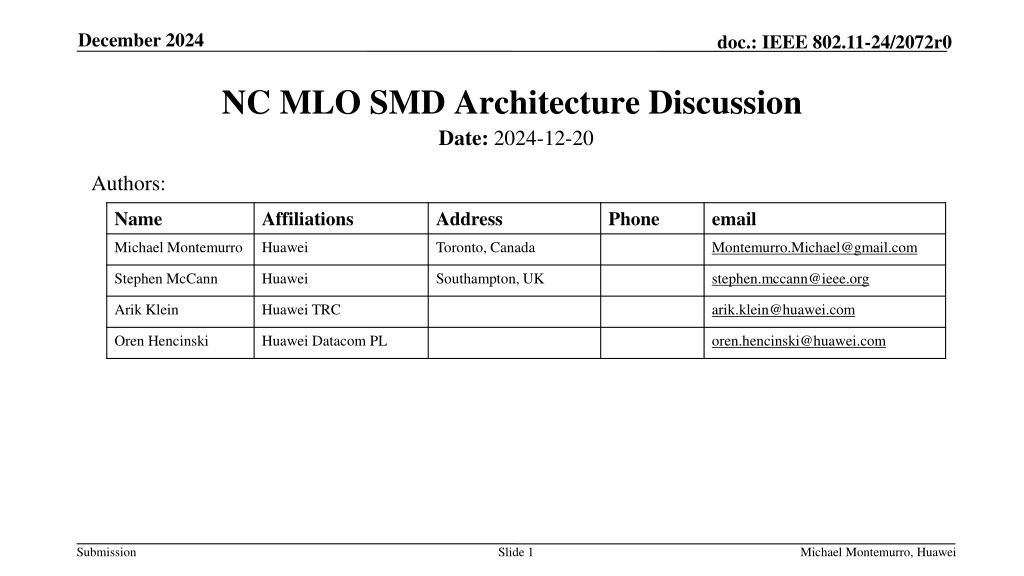
IEEE 802.11-24/2072r0 Document Summary
Explore the architecture and components of the IEEE 802.11-24/2072r0 document discussing seamless roaming, relay technology, and security aspects for over-the-air communications protocols. Delve into the SMD and MD infrastructure topology, architecture components, and representative logical architecture detailing the Mobility Domain and Seamless Mobility Domain with CAPs, MMCs, and APs. Understand the mobility and transition protocols within an SMD, focusing on enhancing Fast BSS-Transition for UHR non-AP MLDs.
Download Presentation

Please find below an Image/Link to download the presentation.
The content on the website is provided AS IS for your information and personal use only. It may not be sold, licensed, or shared on other websites without obtaining consent from the author. If you encounter any issues during the download, it is possible that the publisher has removed the file from their server.
You are allowed to download the files provided on this website for personal or commercial use, subject to the condition that they are used lawfully. All files are the property of their respective owners.
The content on the website is provided AS IS for your information and personal use only. It may not be sold, licensed, or shared on other websites without obtaining consent from the author.
E N D
Presentation Transcript
December 2024 doc.: IEEE 802.11-24/2072r0 NC MLO SMD Architecture Discussion Date: 2024-12-20 Authors: Name Affiliations Address Phone email Michael Montemurro Huawei Toronto, Canada Montemurro.Michael@gmail.com Stephen McCann Huawei Southampton, UK stephen.mccann@ieee.org Arik Klein Huawei TRC arik.klein@huawei.com Oren Hencinski Huawei Datacom PL oren.hencinski@huawei.com Submission Slide 1 Michael Montemurro, Huawei
December 2024 doc.: IEEE 802.11-24/2072r0 Scope IEEE 802.11 standards define protocols that enable over-the-air communications There have been numerous proposals that extend MLO to address seamless roaming, relay, etc. In order to have a meaningful discussion on security for seamless roaming, we need to agree on the architecture. In light of that, the purpose of this work is to define the OTA protocol, assuming the behavior requirements for the architecture Submission Slide 2 Michael Montemurro, Huawei
December 2024 doc.: IEEE 802.11-24/2072r0 SMD and MD infrastructure topology with 11bn ESS MD SMD Includes APs, AP MLDs, and MMCs with CAPs Includes MMC with CAPs Includes APs, AP MLDs, and MMCs with CAPs SMD Seamless Mobility Domain MD (FT) Mobility Domain Submission Slide 3 Michael Montemurro, Huawei
December 2024 doc.: IEEE 802.11-24/2072r0 NC MLD Architecture Components SMD The coverage area which includes the Collocated AP Sets connected with the MMC Multilink Mobility Controller (MMC) A component that provides IEEE 802.1X Authenticator, SME, and Upper MAC functions The MMC anchors the association and DS connectivity for the UHR non-AP MLD NOTE: The full MAC functional breakdown between MMC and a Collocated AP Set beyond basic association functions is TBD Collocated AP Set (CAP) An MLD that is part of the SMD and provides affiliated AP connectivity. The CAP can also function as an AP MLD for legacy MLO connectivity. Each CAP provides lower MAC and PHY functions. Submission Slide 4 Michael Montemurro, Huawei
December 2024 doc.: IEEE 802.11-24/2072r0 Representative Logical SMD/MMC Architecture SMD SMD MMC MMC SME/Upper MAC/IEEE 802.1X Authenticator Backhaul CAP 1 CAP 1 CAP 2 CAP 2 L MAC L MAC AP 1,2 AP 1,1 AP 2,2 AP 2,1 STA 1 STA 2 UHR non UHR non- -AP MLD AP MLD Submission Slide 5 Michael Montemurro, Huawei
December 2024 doc.: IEEE 802.11-24/2072r0 Mobility A UHR non-AP MLD can transition between CAPs that are connect with the same MMC in an SMD, using ML reconfiguration signaling for example. An UHR non-AP MLD can use enhanced Fast BSS-Transition (FT) from an MMC to another MMC within a Mobility Domain. An UHR non-AP MLD can use BSS-Transition from an MMC to another MMC, a non-AP MLD, or an AP within the ESS The focus of 11bn is on defining the protocol used for transition within an SMD and to enhance FT for transition between MMCs. Submission Slide 6 Michael Montemurro, Huawei
December 2024 doc.: IEEE 802.11-24/2072r0 Example of mobility in a logical SMD Topology The UHR non-AP MLD is associated with the MMC1 through CAP 1 with 2 links. Submission Slide 7 Michael Montemurro, Huawei
December 2024 doc.: IEEE 802.11-24/2072r0 Example of mobility in an SMD Topology The UHR non-AP MLD roams, using ML Reconfiguration signaling for example, to maintain its association with the MMC1 through a different set of 2 links (each link is in different location), CAP1 and CAP2. Submission Slide 8 Michael Montemurro, Huawei
December 2024 doc.: IEEE 802.11-24/2072r0 Example of mobility in an SMD Topology The UHR non-AP MLD roams and uses ML Reconfiguration to maintain its association with the MMC1 through a different set of 2 links. Submission Slide 9 Michael Montemurro, Huawei
December 2024 doc.: IEEE 802.11-24/2072r0 Example of mobility in an SMD Topology The UHR non-AP MLD performs FT reassociation with another MMC (MMC2) in the same mobility domain with 2 links Submission Slide 10 Michael Montemurro, Huawei
December 2024 doc.: IEEE 802.11-24/2072r0 Example of mobility in an SMD Topology The UHR non-AP MLD roams and uses ML Reconfiguration to maintain its association with the MMC2 through a different set of 2 links (each link is in different location), CAP3 and CAP4. Submission Slide 11 Michael Montemurro, Huawei
December 2024 doc.: IEEE 802.11-24/2072r0 Work items for P802.11bn 1. Finalize architecture components and their definitions. 2. Specify how the MMC and CAPs are discovered by a UHR non-AP MLD 3. Specify how security associations are created and maintained for mobility, based on architecture. 4. Specify the protocol for transition between CAPs within the SMD, based on the architecture 5. Specify changes to the FT protocol for transition between MMCs Submission Slide 12 Michael Montemurro, Huawei


